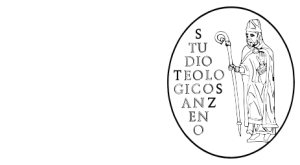
Numero 1
Celebrare e comprendere l'unzione degli infermi
Gennaio - Dicembre 2017
Abstract e allegati
di Luigi GirardiFull Text
di Mauro CaurlaFull Text
Abstract
It would be oversimplified to read Mark 6,13a and James 5,14-15 only as “institutive” texts of the sacrament of The Anointing of the Sick. Instead, we propose to understand them as “tracks” of the ecclesial effect in favour of the sick, which is performed also in the rite of the anointing. At first, the question is presented towards the exegetic investigation of the two texts mentioned, it illustrates briefly the context of the attention and the care for the sick in Jesus’ mission and, in continuity with him, the care of the first christian community (e.g. Acts 3: 1-10). Subsequently, Mark 6.13a and James 5.14-15 are analyzed initially from the context of the reference and the articulation of the phrases, and then by detailed analysis of each verse, in a predominantly synchronous reading that points to some theologically significant issues. At the conclusion, there is a summary of the essential elements that emerged relating to the Sacrament of The Anointing of The Sick (e.g. the relationship between Christ and the Church, the bond between rite and faith, the effects of the sacrament ...). All of this constitutes the biblical basis for a fruitful dialogue with other theological disciplines on the same topic being confronted.
Sommario
Sarebbe riduttivo leggere Mc 6,13a e Gc 5,14-15 solo come testi "istitutivi" del sacramento dell'unzione degli infermi. Si propone piuttosto di comprenderli come "tracce" di quell'agire ecclesiale a favore dei malati che si esplica anche nel rito dell'unzione degli infermi. In un primo momento, presentata la questione e la direzione verso cui si muove l'indagine esegetica dei due testi citati, s'illustra brevemente il contesto dell'attenzione e cura verso gli ammalati di Gesù e, in continuità con Lui, della prima comunità cristiana (cf ad es. At 3,1-10). In un secondo momento si analizzano Mc 6,13a e Gc 5,14-15 a partire dal contesto di riferimento e dall'articolazione dei brani, per passare ad un'analisi dettagliata dei testi, in una lettura prevalentemente sincronica che ne evidenzi alcune questioni teologicamente significative. Nella conclusione sono ripresi in sintesi alcuni elementi essenziali emersi a riguardo del sacramento dell'unzione degli infermi (ad esempio la relazione tra azione di Cristo e della Chiesa, il legame tra rito e fede, gli effetti del sacramento…). Tutto ciò costituisce la base biblica per un dialogo proficuo con le altre discipline teologiche sul tema affrontato.di Cristina SimonelliFull Text
Abstract
The letter that Innocenzo di Roma sends to Decenzio di Gubbio (416 AD), with some explanations on the anointing of the sick, marks a sort of watershed in the reconnaissance of ancient Christian testimonies, with the risk however of being isolated and over-valued. These notes comment on it, trying however, to place it in a wider framework: they gather proof dated from the 2nd century in a Gnostic setting (apolytrosis), prayers of the oil blessing for the sick in the Ecclesiastical System (family of Apostolic Tradition), examples of practices which do not involve anointing in the Augustinian texts, as well as, in the proto-bizantine context, the eucology of the sick and dying of the Euchologion Barberini. The title, however, is derived from a prayer of dying Macrina, accompanied by a specific ritual, which is also observed in the death of Paola (in Gregory of Nissa and Jerome respectively): the whole text encourages the reader to broaden the gaze including the recognition and assistance to dying people and the respective examples. The outcome is a non-unilateral view about specific rituals in the patristic Era. It remains fundamentally unexplored – but it should be pointed out at least – the plexus concerning the comparison with the psychic discomfort, in its condition of the border between neurodiversity and illness.
Sommario
La lettera che Innocenzo di Roma invia a Decenzio di Gubbio (416 dC) con alcune spiegazioni sull’unzione dei malati segna una sorta di spartiacque nella ricognizione delle testimonianze cristiane antiche, con il rischio sia di rimanere isolata che di essere sopravvalutata. Queste note la commentano, cercando però di collocarla in un quadro più ampio: raccolgono testimonianze databili al II secolo in ambiente gnostico (apolytrosis), preghiere di benedizione dell’olio per gli infermi negli Ordinamenti ecclesiastici (famiglia di Tradizione Apostolica), esempi di pratiche che non comportano unzione nei testi agostiniani, nonché, in ambito protobizantino, l’eucologia per i malati e i morenti di Eucologio Barberini. Il titolo è tuttavia desunto da una preghiera di Macrina morente, accompagnata da una ritualità specifica, che si riscontra anche nella morte di Paola (rispettivamente in Gregorio di Nissa e Girolamo): l’insieme invita ad allargare lo sguardo includendo nella ricognizione anche l’accompagnamento alla morte e i modelli relativi. Ne risulta una visione non unilaterale della ritualità specifica in epoca patristica. Resta fondamentalmente inesplorato – ma è opportuno almeno segnalarlo – il plesso riguardante il confronto con il disagio psichico, nella sua condizione di confine fra neurodiversità e malattia.di Alessandro ScardoniFull Text
Abstract
The present contribution analyzes the fifth sacrament in a historical theological key, in its development from the 6th century to the dogmatic fixation presented to the Florentine Council of 1439. The study focuses attention on the important turning point in the Carolingian age, which has led to a deeper sacramental awareness of the rite, it is preferably a symbolic spiritual reading and is placed at the end of life. The research, though in its brevity, allows us to see how historical studies could still contribute to the understanding and reevaluation of the Sacrament of Anointing, for example by investigating better the reasons for the procedure and the context of the application or by investigating the Christian way of dealing with disease when it is discovered. The final impression is that of a unexpectedly rich sacrament.
Sommario
Il presente contributo analizza il quinto sacramento in chiave storico teologica, nel suo sviluppo dal VI secolo alla fissazione dommatica presentata al concilio fiorentino del 1439. Lo studio catalizza particolarmente l’attenzione sulla significativa svolta sopravvenuta in età carolingia, che ha comportato una più piena coscienza sacramentale del rito, una sua lettura preferibilmente simbolico spirituale e la sua ubicazione al termine della vita. La ricerca, pur nella sua brevità, permette di intravvedere quanto studi storici potrebbero ancora contribuire nel comprendere e ripensare l’unzione, ad esempio indagando meglio le ragioni delle modalità e dei contesti di applicazione oppure investigando sul modo cristiano di affrontare la malattia che si rinviene. L’impressione finale è quella di un sacramento insospettabilmente ricco.di Luigi GirardiFull Text
Abstract
The practice and theology of the sacrament of the Anointing of the sick today represents a very particular case for several reasons: for the connection with history that has delivered it to us as “extreme unction”, for the difficult rehabilitation as a sacrament for the sick, for the delicate articulation between illness/health and salvation. The reflective contribution intends to show the “sacramental difference” of the ecclesial Anointing in order to bring out the characteristic of the Grace that the Church celebrates, that is, the possibility for the sick to carry out their own path, in their own body marked by serious illness, towards eschatological salvation. Celebratory practice, reinterpreted in the light of history and the actual process of understanding this tract of human experience, will demonstrate the ability to also show a set of values (e.g. the Ministry of the Church, the ecclesiastical task of the illness itself) and, at the same time, it will propose again in the background, some difficult problems to solve (e.g. the possibility for a wider ministry, the case of mental or psychosomatic illness ...).
Sommario
La prassi e la teologia del sacramento dell’Unzione degli infermi rappresenta oggi un caso del tutto particolare per diversi motivi: per il suo legame con la storia che ce lo ha consegnato come “estrema unzione”, per la sua non facile riabilitazione come sacramento per gli infermi, per la delicata articolazione tra malattia/salute e salvezza. Il contributo riflessivo intende mostrare la “differenza sacramentale” dell’Unzione della Chiesa, in ordine a far emergere la specificità della grazia che essa celebra, ossia la possibilità per il malato di compiere il suo cammino, nel suo corpo segnato dalla grave infermità, verso la salvezza escatologica. La pratica celebrativa, riletta alla luce della storia e della modalità attuale di comprendere questo tratto dell’esperienza umana, si mostrerà capace di mostrare anche un insieme di valori (ad esempio, la ministerialità della Chiesa, il compito ecclesiale del malato stesso) e, nello stesso tempo, riproporrà sullo sfondo alcuni problemi che sono di difficile soluzione (ad esempio, la possibilità di una ministerialità più allargata, il caso delle malattie mentali o psicosomatiche…).di Andrea GainoFull Text
Abstract
The celebration of the sacrament of the Anointing of the sick has been recently known in Pastoral procedures, particularly because of the theological renewal promoted by Vatican Council II – a renewed consideration. From the sacrament that marks the passage from this life to the other life to a sacrament that accompanies life in a difficult moment: during illness. This process is also concerned with the moral theological reflection that questions the meaning and fundamental elements of the Sacrament of Annointing in order to promote its proper acceptance in Pastoral practice. The path of reflection that we are proposing here starts with the relationship between sacrament and illness looking, above all, to investigate it in the anthropological dimension, with particular reference to how our contemporary Western cultural context of today understands and lives with illness. This approach will bring us to briefly address the theological perspective on illness and the sacrament, particularly considering the practice of Jesus and the church of Christian origins, in order to finally highlight the real moral value of the illness experienced.
Sommario
La celebrazione del sacramento dell’Unzione degli infermi ha conosciuto nella prassi pastorale recente, specie per il rinnovamento teologico promosso dal Concilio Vaticano II, una rinnovata attenzione. Da sacramento che segna il passaggio da questa all’altra vita è maturata la sua comprensione come sacramento che accompagna la vita in un suo momento particolare: la malattia. Questo processo di maturazione ha riguardato anche la riflessione teologico morale che si interroga sul significato e sugli elementi costitutivi del sacramento dell’unzione per favorire una sua più corretta recezione nella prassi pastorale. Il percorso di riflessione che qui proponiamo parte dalla relazione tra sacramento e malattia cercando anzitutto di investigarne la dimensione antropologica, con particolare riferimento a come il nostro contesto culturale odierno e occidentale comprende e vive la malattia. Questo approccio porterà poi a confrontarsi brevemente con la prospettiva teologica sulla malattia e sul sacramento, in particolare considerando la prassi di Gesù e della chiesa delle origini cristiane, per poter, infine, evidenziare la valenza propriamente morale della malattia vissuta.di Lucia VantiniFull Text
Abstract
This article moves from the phenomenological lesson of Merleau-Ponty, that suggests to think of the sacred in bodily form and to give back to the narration of the salvation the complexity of the languages of the flesh, that space of intersection between spirit and matter. It emerges therefore how the world penetrates us by experiencing an unavoidable vulnerability. In an extreme situation like serious illness, with all the psychical, spiritual, emotional, and interpersonal implications, the sacrament of the Extreme Unction accompanies the added experience of the history of the figure of Christ and in the communitarian history that emerges from it. The Immersion into the vulnerability of Christ, who has lived his own passion as a form of compassion and as a solidarity to our human fragility, opens a singular and communitarian destiny that demands recognition of the vulnerability of the flesh as something original and to have the courage to expose our own wounds without obscenities and without resignation.
Sommario
L’articolo prende le mosse dalla lezione fenomenologica di Merleau-Ponty, che suggerisce di pensare il sacro in formato corporeo e di restituire alle narrazioni della salvezza la complessità dei linguaggi della carne quale spazio di incrocio tra spirito e materia. Emerge allora come il mondo penetri in noi facendo sperimentare una vulnerabilità inaggirabile. In una situazione-limite come la malattia grave, con tu o il carico psichico, spirituale, affettivo e intersoggettivo connesso, il sacramento dell’Unzione accompagna e innesta l’esperienza nella storia cristologica e nella storia comunitaria che da quella si sprigiona. L’immersione nella feribilità di Cristo, che ha vissuto la propria passione come forma di compassione e come solidarietà alle nostre fragilità umane, apre un destino salvico singolare e comunitario, che domanda di riconoscere la vulnerabilità della carne come qualcosa di originario e di avere il coraggio di esporre le proprie ferite senza oscenità e senza rassegnazione.di Antonio ScattoliniFull Text
Abstract
This article is an essay of an iconological reading that analyses the painting by Giuseppe Maria Crespi dedicated to the Anointing of the sick. This work is part of the pictorial cycle dedicated to the Seven Sacraments: It is a very interesting artistic testimony concerning a fundamental aspect of Christian experience and how one lived in Italy at the beginning of the eighteenth century. Crespi achieves “scenes of a particular kind”, without rhetoric, which have the taste of immediacy and of everyday life. These “snapshots” helps us to think outside of a certain mentality that the liturgy is fundamentally a commandment, as it is perceived, but first and foremost an act of faith; a deep bond between Christians, represented here with their Lord in the words, gestures, and signs of celebration. The importance of these canvases still exists today in their expressive power. The rites as they are represented here, derived from hidden authentic experiences, can communicate with the immediacy of non-verbal symbolic language, rich precisely because it is less univocal than the theoretical language.
Sommario
L’articolo è un saggio di lettura iconologica. Analizza il dipinto di Giuseppe Maria Crespi dedicato all’Unzione degli Infermi, che fa parte del ciclo pittorico dedicato ai Sette Sacramenti: interessantissima testimonianza artistica riguardante un aspetto fondamentale dell'esperienza cristiana, così come si viveva all'inizio del settecento in Italia. Crespi realizza “scene di genere”, prive di retorica, che hanno il sapore dell’immediatezza e della quotidianità. Queste “istantanee” ci aiutano a uscire da una mentalità che pensa la liturgia fondamentalmente come precetto, per farcela percepire anzitutto come atto di fede e legame profondo dei cristiani qui rappresentati con il loro Signore presente nelle parole, nei gesti e nei segni delle celebrazioni. L’importanza di queste tele sta ancor oggi nella loro potenza espressiva. Come i riti che raffigurano, anche questi dipinti, proprio perché nascono da esperienze autentiche, sanno comunicare con immediatezza sul piano non verbale del linguaggio simbolico, ricco proprio perché meno univoco del linguaggio teorico.di Gianni NalettoFull Text
Abstract
This article draws inspiration from the experiences of a hospital chaplain and it suggests the correct proximity to the patient, that includes the awareness of the circumstances of the human being that is suffering and is capable of transforming this evangelical proof into concern and refers to the saving action the Lord Jesus Christ. The act of the "Good Samaritan" is an icon of a pastoral accompanying practice in the illness.
Sommario
L’articolo trae spunto dall’esperienza vissuta come cappellano in ospedale e suggerisce attenzioni per una corretta vicinanza al malato, che sappia essere attenta alla situazione della persona sofferente e capace di tradursi in testimonianza evangelica come sollecitudine, cura e rimando all’azione Salvifica del Signore Gesù. L’agire del “buon Samaritano” è icona in riferimento alla quale si concentra la riflessione per una prassi di accompagnamento pastorale nella malattia.di Pierpaolo ValliFull Text
Abstract
This article features an outline of some of the experiences of the author in his care of people who live with the loss of a loved one, both in individual interviews and in conducting self help groups -of which the aims and processes are presented. Through this practice of assistance we have the opportunity to enter the “world of tears": a delicate place, rich in experience but also in pain.
Sommario
L’articolo presenta alcuni tratti dell’esperienza vissuta dall’autore accanto a chi vive l’esperienza della perdita di una persona cara, sia nei colloqui individuali che nell’animazione di gruppi di auto mutuo aiuto. Di quest’ultima si indicano scopi e modalità. Attraverso la prassi di accompagnamento si ha l’opportunità di entrare nel “paese delle lacrime”: luogo delicato, ricco di vissuto ma anche carico di sofferenza.di Placido SgroiFull Text
di Luca MerloFull Text
Numeri precedentiVedi tutti

Alla ricerca dei ministeri battesimali
Vai al sommario

Teologia e formazione. Studi in memoria di don Serio De Guidi
Vai al sommario

Salvati per Gesù, morto e risorto
Vai al sommario

Divenire Chiesa: soggetti e comunità
Vai al sommario





